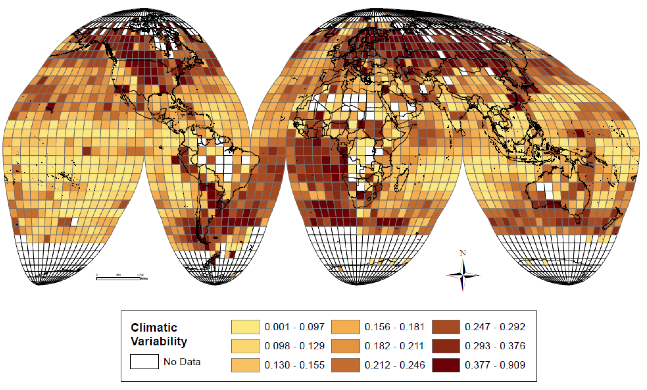
The evolution of culture and tradition, along with their persistence, can be explained by environmental instability
Increasingly, economists are coming to understand the role of culture and its importance for economic development (Spolaore and Wacziarg 2013). One characteristic of culture is that it is often quite persistent (Fischer 1989, Fernandez 2007, Giuliano 2007, Fernandez and Fogli 2009, Algan and Cahuc 2010, Voigtlaender and Voth 2012), and yet there are also many examples of dramatic changes (Becker and Woessmann 2008, Cantoni 2012, Mead 1956, Firth 1959, Kupperman 1995). This raises the natural question: When does culture change and when does it persist? In particular, what determines a society’s willingness to adopt new customs and beliefs rather than hold onto traditions?
In a recent study, we tackle exactly this question and test for a determinant of cultural persistence that has been well-developed theoretically in the evolutionary anthropology literature (Giuliano and Nunn 2017). This determinant is the stability of the environment across generations.
Why the stability of environment matters
The intuition for why this matters is as follow. First, consider a population living in a very stable environment. In this setting, the customs and beliefs of one’s ancestors are particularly relevant in deciding what actions are best.. Given that the customs and beliefs have evolved and survived up until the previous generation, it is likely that they are beneficial. Next, consider a population living in a very unstable environment, where the setting of each generation changes so much that the customs and beliefs of the previous generation are unlikely to be relevant for the current generation. In such a setting, the traditions of one’s ancestors are less relevant and less likely to be beneficial.
Our study
We take this hypothesis to the data and test whether societies with ancestors that historically lived in environments with more environmental instability across generations:
- value tradition less;
- are more likely to adopt new cultural values;
- exhibit less cultural persistence over time.
We measure the variability of the environment across generations by using data on temperature anomalies within defined units of area. To do so, we divide the world into areas defined by 0.5°-by-0.5° grid cells beginning in 500 CE. The variation in our constructed variability measure is shown visually in Figure 1.
Figure 1 Climatic variation across the world since 500 CE

Strategy and results
Our empirical analysis uses four strategies to test this hypothesis of interest:
- We examine self-reported views of the importance of tradition. Looking across either countries or ethnic groups within countries, we find that having ancestors that experienced more climatic instability across generations is associated with a weaker belief in the importance of maintaining traditions and customs today.
- We measure the importance placed on tradition as revealed by the observed persistence of cultural traits. We examine three cultural practices for data available across societies and over long periods of time: female participation in work outside the home, polygamy, and cousin marriage. We find that although these traits have tended to persist historically, there is significant variation. There is much weaker persistence for countries with ancestors that experienced a greater instability of their climate from one generation to the next. For the least stable societies, persistence is close to zero, while for the most stable it is fairly close to one.
- We examine the stability of a group’s customs and traditions when faced with a large shock that causes these traditions to change. Specifically, we study the descendants of immigrants who moved to the US. Immigrants bring their traditional customs with them, but live in a new environment with a new set of practices and values. This leads to a natural weakening of traditional practices. Our analysis examines whether children of immigrants marry someone from the same ancestral group and whether they continue to speak their ancestral language at home. Interestingly, we find that the descendants of immigrants from countries that were more unstable historically are less likely to hold onto the tradition of their homeland.
One potential concern with the immigrant analysis is that immigrants are not necessarily a representative sample of the origin population. In addition, non-representativeness may differ systematically in a manner that is correlated with climatic instability and cultural persistence.
- Given the above concerns, we examine non-immigrant populations that are faced with pressure to change their traditions and customs – namely, Indigenous populations of the US and Canada.
Like immigrants, Indigenous populations are minority groups whose cultural traditions differ from those of the majority population. However, unlike immigrants, they are not a small group selected by the immigration process. Our analysis examines the relationship between the cross-generational climatic instability of the land historically inhabited by the Indigenous groups and the extent to which they are still able to speak their traditional language today. We find that, as with the descendants of immigrants, Indigenous populations with greater historical instability are less likely to speak their traditional language. They are more likely to have abandoned this cultural tradition and to have adopted English as their mother tongue.
Implications
All four strategies reach the same conclusion. Tradition is less important and culture less persistent among populations with ancestors who lived in environments that were historically less stable across generations. In addition to providing a better understanding of when we expect culture to persist and when we expect it to change, our study also provides a direct test of a class of model from evolutionary anthropology. The core characteristic of these models is the assumption that culture evolves systematically based on the relative costs and benefits of the cultural traits. Our findings provide support for the evolution of culture as modelled in evolutionary anthropology literature, as compared to alternative models which suggest that culture is not systematic at all, and therefore cannot be explained. Testing these models is important because many of the current models of culture in economics1 implicitly built on a number of important outcomes of models from evolutionary anthropology, such as the assumption of vertical transmission and social learning. This is particularly important since the models in evolutionary anthropology are crucial for the assumptions of many models used in cultural economics.
Editor’s note: This article is published in collaboration with Ideas for India.
References
Algan, Y and P Cahuc (2010), “Inherited trust and growth,” American Economic Review 100(5): 2060–2092.
Becker, O and L Woessmann (2009), “Was Weber wrong? A human capital theory of Protestant economic history,” Quarterly Journal of Economics 124(2): 531–596[CA7] .
Cantoni, D (2012), “Adopting a new religion: The case of Protestantism in 16th century Germany,” Economic Journal 122(560): 502–531.
Fernandez, R (2007), “Women, work and culture,” Journal of the European Economic Association 5(2–3): 305–332.
Fernandez, R and A Fogli (2009), “Culture: An empirical investigation of beliefs, work, and fertility,” American Economic Journal: Macroeconomics 1(1): 146–177.
Firth, Raymond (1959), Social change in Tikopia: Re-Study of a Polynesian community after a generation, New York: George Allen and Unwin Ltd.
Fischer, D (1989), Albion’s seed: Four British folkways in America, New York: Oxford University Press.
Giuliano, P (2007), “Living arrangements in western Europe: Does cultural origin matter?”, Journal of the European Economic Association 5 5): 927–952.
Giuliano, P and N Nunn (2017), “Understanding cultural persistence and change,”, NBER Working Paper No. 23617.
Kupperman, K (1995), Providence Island, 1630–1641: The other Puritan colony, Cambridge: Cambridge University Press.
Mead, M (1956), New Lives for old: Cultural transformation – Manus, 1928–1953, New York: William Morrow & Co.
Spolaore, E and R Wacziarg (2013), “How deep are the roots of economic development?,” Journal of Economic Literature 51(2): 325–369.
Voigtlaender, N and H-J Voth (2012), “Persecution perpetuated: The medieval origins of anti-Semitic violence in Nazi Germany,” Quarterly Journal of Economics 127(3): 1339–1392.
Endnotes
[1] See, for example, Bisin and Verdier (2000, 2001, 2017), Hauk and Saez-Marti (2002), Francois and Zabojnik (2005), Tabellini (2008), and Doepke and Zilibotti (2017).


